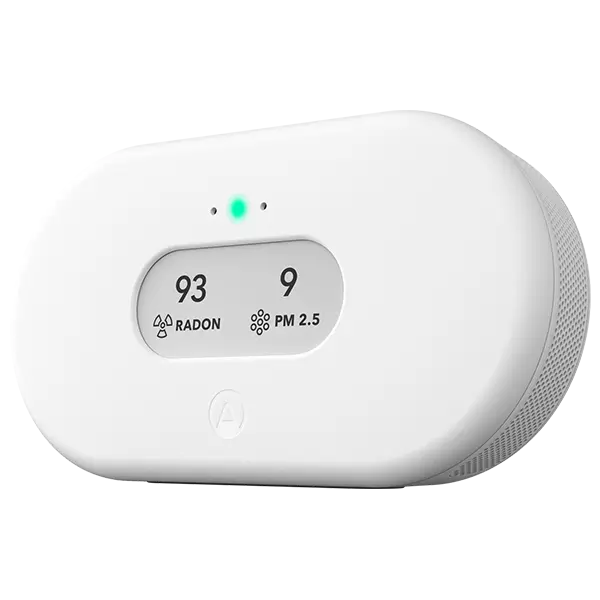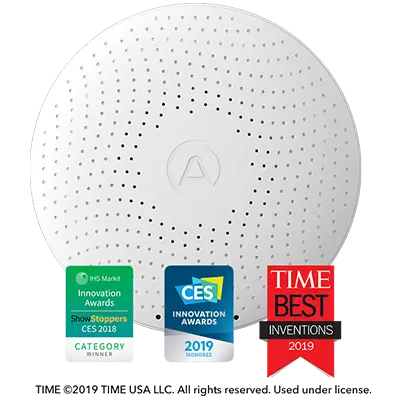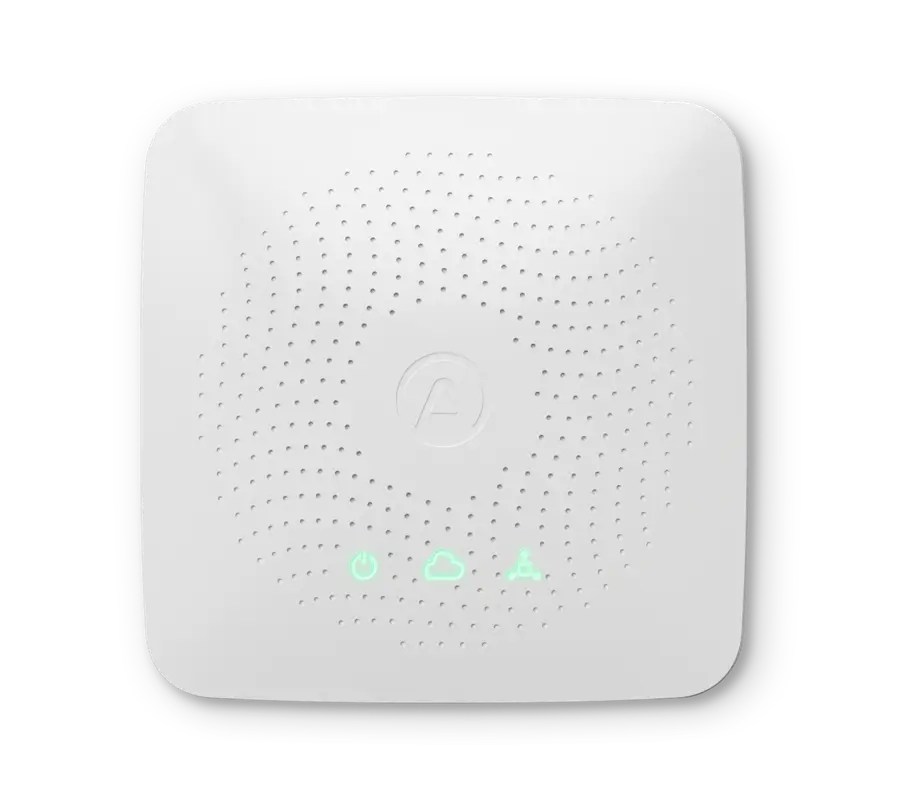Learn how to boost your family's well-being by monitoring indoor air quality.
Many people now think that well-being is the key to a happy home but it is a bigger idea than just being physically healthy. It's also about emotional and psychological health, promoting wellness as well as avoiding disease, and developing a positive, balanced relationship with the natural environment and the people around you.
Millions of people worldwide are seeking to improve their well-being, growing a huge $4.2 trillion dollar market as they go. Even if you haven't thought about it in the context of your own home, it's likely that you already do quite a lot to boost your family's health.
Diet and exercise – are they enough when it comes to well-being?

Take fitness for example – most families recognize the need for their kids to get at least one hour of moderate to strong physical activity a day – whether it's playing team sports, having fun with the family or putting the screen down and getting off the couch. Grown-ups too are getting in on the action, using the latest technology to monitor their progress in shedding those extra pounds. Fitness apps were the most popular smartwatch application in 2017.

Who hasn't heard of healthy eating? We're all getting the message to ditch sugar, fat and salt, with many of us taking that further into detoxing, buying local, switching to vegan or vegetarian or swapping processed foods for whole foods.
We now pay far more attention to what we put into our bodies, from its nutritional content to where it was sourced and how it was made. Some people are boosting their well-being with personalized nutrition plans based on their unique DNA profile, with apps to track what they eat and suggest recipes.

Clean air is essential to well-being

People are getting the message that there is a direct connection between what goes into our bodies and our well-being. But there's one big piece of the well-being puzzle that's missing – the air we breathe. Breathing in pure, fresh air every day is central to improving the overall well-being of your household.
Clean air should be factored into how we promote well-being. After all, we take more air into our bodies than we do food – we might eat three times a day, but we breathe on average 20 times a minute.
But it's getting increasingly harder to get the clean air we need. More than half the world's population now lives in urban areas, with more migrating every day. Busy towns and cities have poorer air, and many people find themselves cut off from the fresh air of green spaces.
The nature of 21st-century living means that we spend most of our time indoors – a huge 90% – so clean indoor air is particularly important to our well-being. However, good indoor air quality (IAQ) is hard to maintain – if the air outside is poor, opening a window is not an option and with many contaminants coming from indoors, indoor air can often be five to 10 times worse than outdoor air.
How to improve your family's well-being with better IAQ

Well-being is not so much better living, rather smarter living. As you've seen from the examples above, the latest technologies are playing a big part in helping people achieve better overall health.
And it's the same when it comes to IAQ. Now you can use a smart system to improve your household air. A wireless wall-mounted device will continuously monitor the indoor environment, feeding that data into an app, which will prompt you to take action if it drops below healthy thresholds.
With the right IAQ system, you can monitor your indoor air for the elements that have the biggest impact on your family's well-being:
Radon |
Radon is a naturally occurring, invisible gas emanating from the ground. It seeps inside through cracks, drains and other small openings in the foundation of homes and buildings.
The problem is, it's radioactive and emits alpha particles that can damage DNA. Nevertheless, it's often left unmeasured, untested, and unchecked.
The risks of long-term exposure to radon gas are serious, and inside the home is the single biggest source. If you are breathing in high concentrations of radon, the alpha radiation can damage your DNA, and if you are exposed over a long period of time, your body cannot repair itself. This increases the likelihood of developing lung cancer. Approximately 21,000 people in the US and 20,000 in the EU die from radon-related lung cancer every year. It's the largest cause of lung cancer amongst non-smokers.
Since indoor levels of radon fluctuate greatly and it is all around us as part of the air we breathe, you never know when you are being exposed to more or less, unless you monitor it continuously. The right monitoring system will tell you when you need to take action, such as improving ventilation.
Total VOCs |
TVOCs stands for Total Volatile Organic Compounds, which describes the total amount of emitted gases coming from toxins, chemicals, and odors that have short and long-term health effects.
VOCs are found in everyday products and materials including mattresses, household cleaners, and even paint, so it’s important to monitor, extract, and choose low-VOC products where possible.
VOCs can irritate the lining of your nose and upper respiratory tract, set off asthma, and other allergies and give you headaches. Prolonged exposure to high concentrations can even lead to more serious health conditions.
There are many ways to lower your total VOC levels, like buying used furniture and choosing natural cleaners and detergents. One remedy is to lessen the sources of VOCs in your home by choosing household products with low-VOC toxicity. The other is to use your IAQ monitoring system to alert you to high levels so you can increase ventilation and regularly replace your indoor air filters.
Carbon dioxide (CO2) |
CO2 is everywhere around us. In fact, we can't live without it, because trees use it to photosynthesize and produce oxygen. Every time we breathe out, we emit it. It's harmless in low concentrations, but if you are in an enclosed space and concentrations exceed 1,000ppm, then it will negatively affect your well-being.
When CO2 levels rise, the room is filled with stagnant, stale, stuffy air, which lowers your attention span, impairs your concentration, and makes you tired and nauseous. Studies have shown that high CO2 and poor ventilation leads to poorer cognitive performance and higher infectious disease transmission.
By monitoring your indoor air and taking measures to decrease CO2 when necessary, your family is armed with the oxygen and brain capacity to tackle everything that life has to offer.
Humidity |
Dry air may not seem dangerous, but it can make infectious disease transmission easier, while more humid conditions can cause mold growth and worsen asthma symptoms.
By monitoring humidity, you can keep your home at a healthy humidity range – between 30% and 60%. That way, you avoid problems caused by high humidity, such as mold, dust mites, asthma, allergies, and respiratory infections. Further conditions caused by dry air include dry skin, nose bleeds, respiratory tract irritation, and the transmission of some nasty bugs, such as the influenza virus.
Temperature |
Indoor air temperature has a significant effect on your family's well-being – and it's not just comfort levels. Studies have shown that when the temperature is too high, it affects cognitive ability. For every one degree F increase above average temperature, there is a corresponding performance drop of 1%.
So think about how that affects concentration when studying for exams, working from home, or doing the household budget – and use your IAQ monitor to keep indoor air temperature at optimal levels.
Pressure |
You may have heard the weather forecasters on TV talking about ‘pressure’; the pressure changes according to the weather – low pressure, rain is on the way; high pressure, the air will be dry. But how does that impact you when you’re inside your home? Barometric pressure is also known as the ‘weight of air’ and when increased can cause headaches.
IAQ is just as important to your family's well-being as good nutrition and plenty of exercise. And like so much these days, the key to unlocking its benefits lies in the right technology.
Takeaways
- Boosting well-being involves promoting good health as well as avoiding disease.
- Indoor air quality is just as important to well-being as a healthy diet and good exercise.
- Smart tech solutions are at the heart of the modern approach to well-being.
- The right IAQ monitoring system will help protect your family from contaminants and an unhealthy indoor environment.
- Poor IAQ compromises cognitive function and resistance to bugs while raising the risk of asthma exacerbations and cancer.













%20(1).webp)

%20(1).webp)
